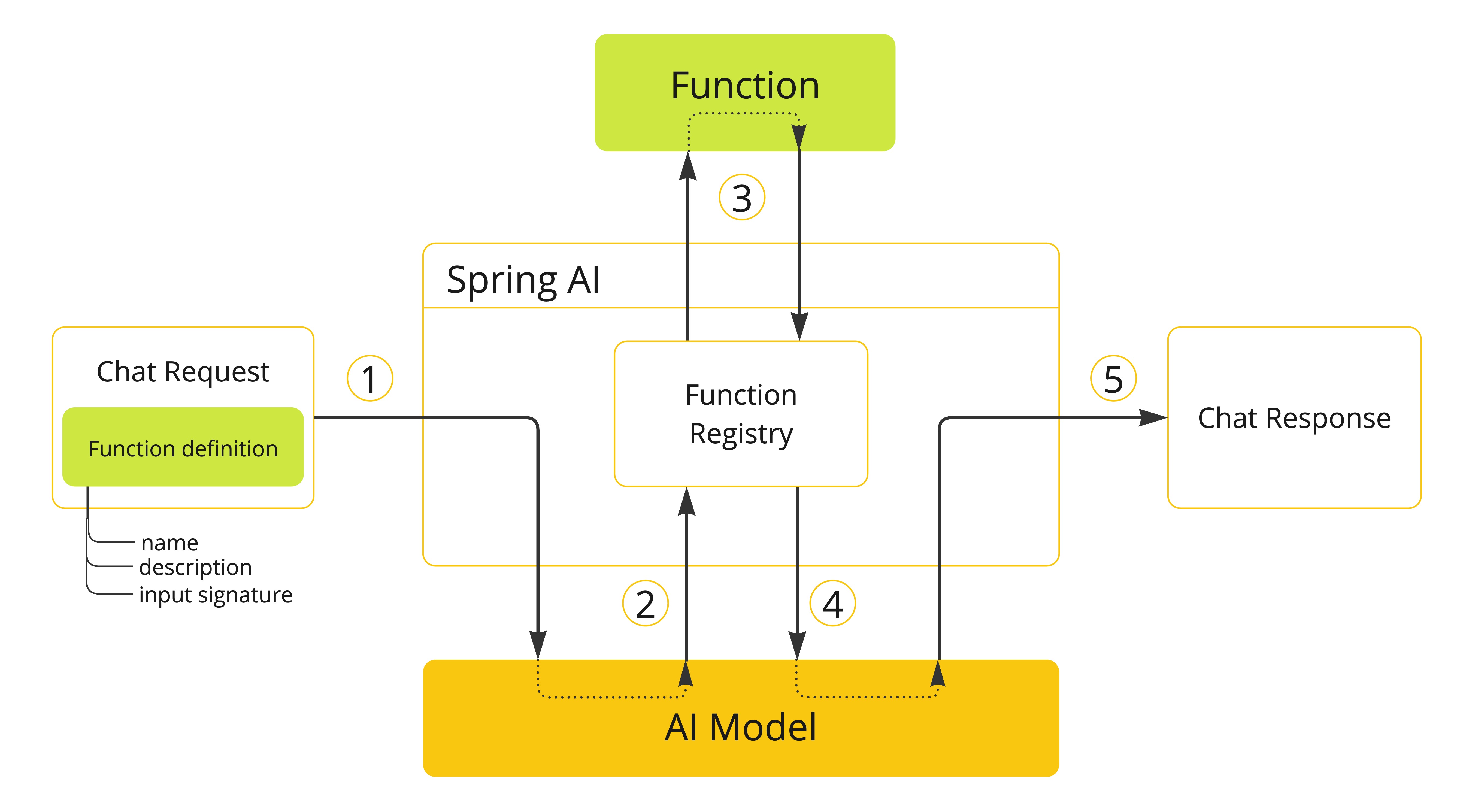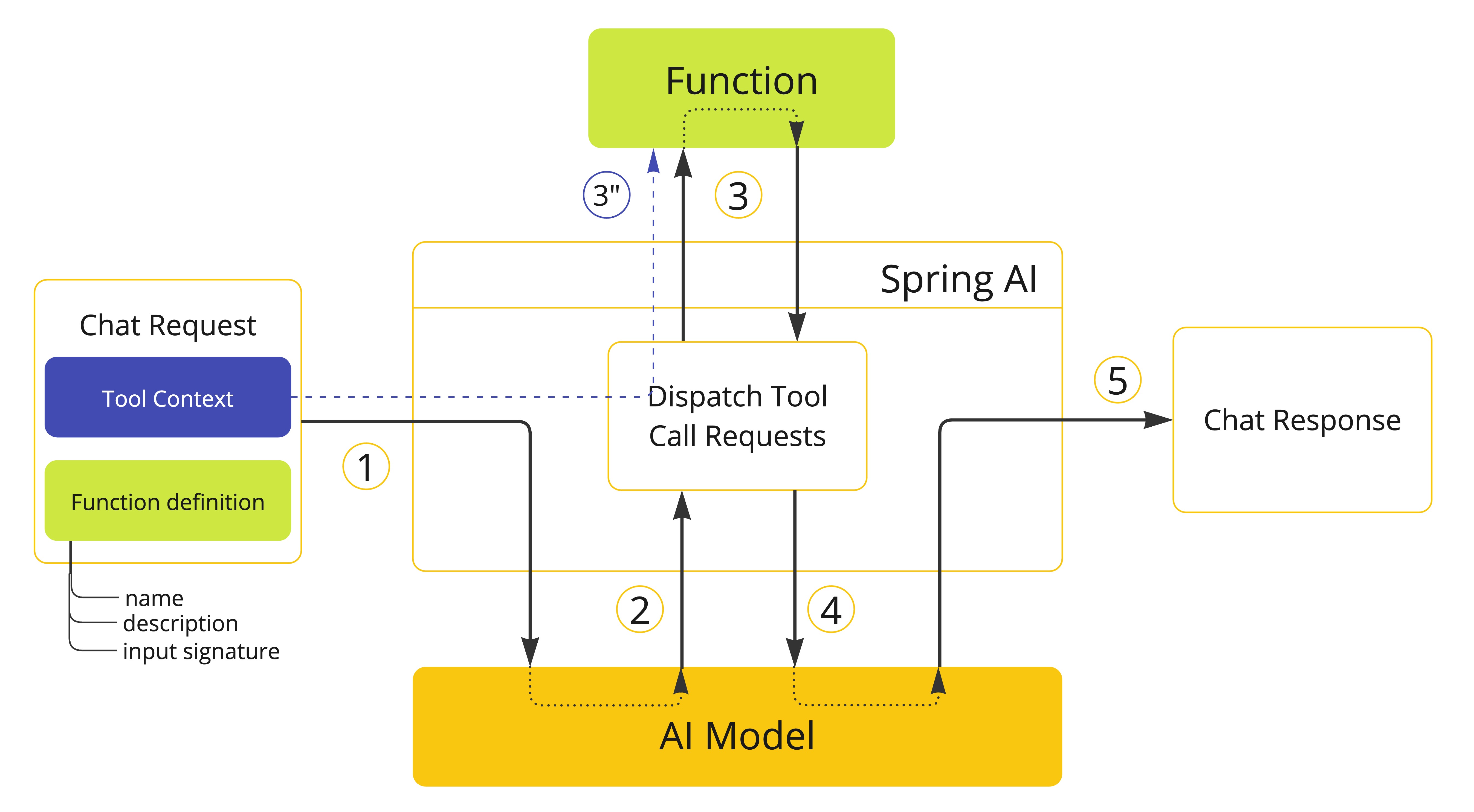函数调用 API
| 本页介绍了函数调用 API 的先前版本,该版本已弃用并标记为在下一版本中删除。当前版本可在 Tool Calling 中找到。有关更多信息,请参阅迁移指南。 |
在 AI 模型中集成函数支持,允许模型请求执行客户端函数,从而根据需要访问必要的信息或动态执行任务。
Spring AI 目前支持对以下 AI 模型进行工具/函数调用:
-
Anthropic Claude:请参阅 Anthropic Claude 工具/函数调用。
-
Azure OpenAI:请参阅 Azure OpenAI 工具/函数调用。
-
Amazon Bedrock Converse:请参阅 Amazon Bedrock Converse 工具/函数调用。
-
Google VertexAI Gemini:请参阅 Vertex AI Gemini 工具/函数调用。
-
Groq:请参阅 Groq 工具/函数调用。
-
Mistral AI:请参阅 Mistral AI 工具/函数调用。
-
Ollama:参考 Ollama 工具/函数调用
-
OpenAI:请参阅 OpenAI 工具/函数调用。

您可以使用ChatClient并让 AI 模型智能地选择输出包含参数的 JSON 对象,以调用一个或多个已注册的函数。
这允许您将 LLM 功能与外部工具和 API 连接起来。
AI 模型经过训练,可以检测何时应该调用函数,并使用符合函数签名的 JSON 进行响应。
API 不直接调用该函数;相反,该模型会生成 JSON,您可以使用该 JSON 在代码中调用函数,并将结果返回给模型以完成对话。
Spring AI 提供了灵活且用户友好的方法来注册和调用自定义函数。
通常,自定义函数需要提供一个函数name,description和函数调用signature(作为 JSON 架构)让模型知道函数需要哪些参数。这description帮助模型了解何时调用函数。
作为开发人员,您需要实现一个函数,该函数采用从 AI 模型发送的函数调用参数,并将结果返回给模型。您的函数可以反过来调用其他第三方服务来提供结果。
Spring AI 使这就像定义@Bean定义,该定义返回一个java.util.Function并在调用ChatClient或在提示请求中动态注册函数。
在后台, Spring 使用适当的适配器代码包装您的 POJO(函数),以便与 AI 模型进行交互,从而避免编写繁琐的样板代码。 底层基础架构的基础是 FunctionCallback.java 接口和配套的 Builder 实用程序类,以简化 Java 回调函数的实现和注册。
运作方式
假设我们希望 AI 模型使用它没有的信息进行响应,例如,给定位置的当前温度。
我们可以为 AI 模型提供有关我们自己的函数的元数据,它可以在处理您的提示时使用这些元数据来检索该信息。
例如,如果在处理提示期间,AI 模型确定它需要有关给定位置温度的其他信息,它将启动服务器端生成的请求/响应交互。 AI 模型不会返回最终响应消息,而是在特殊的 Tool Call 请求中返回,提供函数名称和参数(作为 JSON)。 客户端负责处理此消息并执行命名函数并返回响应 作为 Tool Response 消息返回给 AI 模型。
Spring AI 大大简化了您需要编写以支持函数调用的代码。
它为您代理函数调用对话。
您可以简单地将函数定义作为@Bean,然后在提示选项中提供函数的 Bean 名称,或在提示请求选项中直接将函数作为参数传递。
您还可以在提示符中引用多个函数 Bean 名称。
示例用例
让我们定义一个简单的用例,我们可以将其用作示例来解释函数调用的工作原理。 让我们创建一个聊天机器人,通过调用我们自己的函数来回答问题。 为了支持聊天机器人的响应,我们将注册自己的函数,该函数获取一个位置并返回该位置的当前天气。
当模型需要回答诸如"What’s the weather like in Boston?"AI 模型将调用客户端,提供 location 值作为要传递给函数的参数。这种类似 RPC 的数据以 JSON 形式传递。
我们的函数调用一些基于 SaaS 的天气服务 API,并将天气响应返回给模型以完成对话。在此示例中,我们将使用一个名为MockWeatherService对不同位置的温度进行硬编码。
以下内容MockWeatherServiceclass 表示天气服务 API:
-
Java
-
Kotlin
public class MockWeatherService implements Function<Request, Response> {
public enum Unit { C, F }
public record Request(String location, Unit unit) {}
public record Response(double temp, Unit unit) {}
public Response apply(Request request) {
return new Response(30.0, Unit.C);
}
}class MockWeatherService : Function1<Request, Response> {
override fun invoke(request: Request) = Response(30.0, Unit.C)
}
enum class Unit { C, F }
data class Request(val location: String, val unit: Unit) {}
data class Response(val temp: Double, val unit: Unit) {}服务器端注册
函数作为 Bean
Spring AI 提供了多种在 Spring 上下文中将自定义函数注册为 bean 的方法。
我们首先介绍对 POJO 最友好的选项。
普通函数
在此方法中,您将定义一个@Bean就像你对待任何其他 Spring 托管对象一样。
在内部,Spring AIChatModel将创建一个FunctionCallback这增加了通过 AI 模型调用它的逻辑。
的名称@Bean是使用函数名称。
-
Java
-
Kotlin
@Configuration
static class Config {
@Bean
@Description("Get the weather in location") // function description
public Function<MockWeatherService.Request, MockWeatherService.Response> currentWeather() {
return new MockWeatherService();
}
}@Configuration
class Config {
@Bean
@Description("Get the weather in location") // function description
fun currentWeather(): (Request) -> Response = MockWeatherService()
}这@Descriptionannotation 是可选的,它提供了一个函数描述,可帮助模型了解何时调用该函数。这是一个重要的属性,可帮助 AI 模型确定要调用的客户端函数。
提供函数描述的另一种方法是使用@JsonClassDescription注解MockWeatherService.Request:
-
Java
-
Kotlin
@Configuration
static class Config {
@Bean
public Function<Request, Response> currentWeather() { // bean name as function name
return new MockWeatherService();
}
}
@JsonClassDescription("Get the weather in location") // function description
public record Request(String location, Unit unit) {}@Configuration
class Config {
@Bean
fun currentWeather(): (Request) -> Response { // bean name as function name
return MockWeatherService()
}
}
@JsonClassDescription("Get the weather in location") // function description
data class Request(val location: String, val unit: Unit)最佳实践是使用信息对请求对象进行注释,以便为该函数生成的 JSON 架构尽可能具有描述性,以帮助 AI 模型选择要调用的正确函数。
函数回调
注册函数的另一种方法是创建一个FunctionCallback喜欢这个:
-
Java
-
Kotlin
@Configuration
static class Config {
@Bean
public FunctionCallback weatherFunctionInfo() {
return FunctionCallback.builder()
.function("CurrentWeather", new MockWeatherService()) // (1) function name and instance
.description("Get the weather in location") // (2) function description
.inputType(MockWeatherService.Request.class) // (3) input type to build the JSON schema
.build();
}
}import org.springframework.ai.model.function.withInputType
@Configuration
class Config {
@Bean
fun weatherFunctionInfo(): FunctionCallback {
return FunctionCallback.builder()
.function("CurrentWeather", MockWeatherService()) // (1) function name and instance
.description("Get the weather in location") // (2) function description
// (3) Required due to Kotlin SAM conversion being an opaque lambda
.inputType<MockWeatherService.Request>()
.build();
}
}
It wraps the 3rd party MockWeatherService function and registers it as a CurrentWeather function with the ChatClient.
It also provides a description (2) and an optional response converter to convert the response into a text as expected by the model.
By default, the response converter performs a JSON serialization of the Response object.
The FunctionCallback.Builder internally resolves the function call signature based on the MockWeatherService.Request class.
Enable functions by bean name
To let the model know and call your CurrentWeather function you need to enable it in your prompt requests:
ChatClient chatClient = ...
ChatResponse response = this.chatClient.prompt("What's the weather like in San Francisco, Tokyo, and Paris?")
.functions("CurrentWeather") // Enable the function
.call().
chatResponse();
logger.info("Response: {}", response);
The above user question will trigger 3 calls to the CurrentWeather function (one for each city) and the final response will be something like this:
Here is the current weather for the requested cities:
- San Francisco, CA: 30.0°C
- Tokyo, Japan: 10.0°C
- Paris, France: 15.0°C
The FunctionCallbackWithPlainFunctionBeanIT.java test demo this approach.
Client-Side Registration
In addition to the auto-configuration, you can register callback functions, dynamically.
You can use either the function invoking or method invoking approaches to register functions with your ChatClient or ChatModel requests.
The client-side registration enables you to register functions by default.
Function Invoking
ChatClient chatClient = ...
ChatResponse response = this.chatClient.prompt("What's the weather like in San Francisco, Tokyo, and Paris?")
.functions(FunctionCallback.builder()
.function("currentWeather", (Request request) -> new Response(30.0, Unit.C)) // (1) function name and instance
.description("Get the weather in location") // (2) function description
.inputType(MockWeatherService.Request.class) // (3) input type to build the JSON schema
.build())
.call()
.chatResponse();
The on the fly functions are enabled by default for the duration of this request.
This approach allows to choose dynamically different functions to be called based on the user input.
The FunctionCallbackInPromptIT.java integration test provides a complete example of how to register a function with the ChatClient and use it in a prompt request.
Method Invoking
The MethodInvokingFunctionCallback enables method invocation through reflection while automatically handling JSON schema generation and parameter conversion.
It’s particularly useful for integrating Java methods as callable functions within AI model interactions.
The MethodInvokingFunctionCallback implements the FunctionCallback interface and provides:
-
Automatic JSON schema generation for method parameters
-
Support for both static and instance methods
-
Any number of parameters (including none) and return values (including void)
-
Any parameter/return types (primitives, objects, collections)
-
Special handling for ToolContext parameters
You need the FunctionCallback.Builder to create MethodInvokingFunctionCallback like this:
// Create using builder pattern
FunctionCallback methodInvokingCallback = FunctionCallback.builder()
.method("MethodName", Class<?>...argumentTypes) // The method to invoke and its argument types
.description("Function calling description") // Hints the AI to know when to call this method
.targetObject(targetObject) // Required instance methods for static methods use targetClass
.build();
Here are a few usage examples:
-
Static Method Invocation
-
Instance Method with ToolContext
public class WeatherService {
public static String getWeather(String city, TemperatureUnit unit) {
return "Temperature in " + city + ": 20" + unit;
}
}
// Usage
FunctionCallback callback = FunctionCallback.builder()
.method("getWeather", String.class, TemperatureUnit.class)
.description("Get weather information for a city")
.targetClass(WeatherService.class)
.build();
public class DeviceController {
public void setDeviceState(String deviceId, boolean state, ToolContext context) {
Map<String, Object> contextData = context.getContext();
// Implementation using context data
}
}
// Usage
DeviceController controller = new DeviceController();
String response = ChatClient.create(chatModel).prompt()
.user("Turn on the living room lights")
.functions(FunctionCallback.builder()
.method("setDeviceState", String.class,boolean.class,ToolContext.class)
.description("Control device state")
.targetObject(controller)
.build())
.toolContext(Map.of("location", "home"))
.call()
.content();
The OpenAiChatClientMethodInvokingFunctionCallbackIT
integration test provides additional examples of how to use the FunctionCallback.Builder to create method invocation FunctionCallbacks.
Tool Context
Spring AI now supports passing additional contextual information to function callbacks through a tool context.
This feature allows you to provide extra, user provided, data that can be used within the function execution along with the function arguments passed by the AI model.

The ToolContext class provides a way to pass additional context information.
Using Tool Context
In case of function-invoking, the context information that is passed in as the second argument of a java.util.BiFunction.
For method-invoking, the context information is passed as a method argument of type ToolContext.
Function Invoking
You can set the tool context when building your chat options and use a BiFunction for your callback:
BiFunction<MockWeatherService.Request, ToolContext, MockWeatherService.Response> weatherFunction =
(request, toolContext) -> {
String sessionId = (String) toolContext.getContext().get("sessionId");
String userId = (String) toolContext.getContext().get("userId");
// Use sessionId and userId in your function logic
double temperature = 0;
if (request.location().contains("Paris")) {
temperature = 15;
}
else if (request.location().contains("Tokyo")) {
temperature = 10;
}
else if (request.location().contains("San Francisco")) {
temperature = 30;
}
return new MockWeatherService.Response(temperature, 15, 20, 2, 53, 45, MockWeatherService.Unit.C);
};
ChatResponse response = chatClient.prompt("What's the weather like in San Francisco, Tokyo, and Paris?")
.functions(FunctionCallback.builder()
.function("getCurrentWeather", this.weatherFunction)
.description("Get the weather in location")
.inputType(MockWeatherService.Request.class)
.build())
.toolContext(Map.of("sessionId", "1234", "userId", "5678"))
.call()
.chatResponse();
In this example, the weatherFunction is defined as a BiFunction that takes both the request and the tool context as parameters. This allows you to access the context directly within the function logic.
This approach allows you to pass session-specific or user-specific information to your functions, enabling more contextual and personalized responses.
Method Invoking
public class DeviceController {
public void setDeviceState(String deviceId, boolean state, ToolContext context) {
Map<String, Object> contextData = context.getContext();
// Implementation using context data
}
}
// Usage
DeviceController controller = new DeviceController();
String response = ChatClient.create(chatModel).prompt()
.user("Turn on the living room lights")
.functions(FunctionCallback.builder()
.method("setDeviceState", String.class,boolean.class,ToolContext.class)
.description("Control device state")
.targetObject(controller)
.build())
.toolContext(Map.of("location", "home"))
.call()
.content();